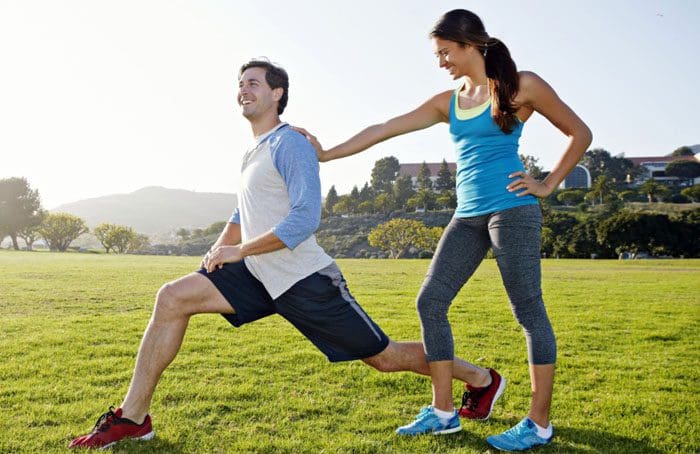
Finding the right physical activity that elevates heart rate and maintains it for 30 minutes a day increases the amount of oxygen delivered to the heart, brain, and muscles. Some form of aerobic activity will keep individuals moving in a healthy direction. ​This benefits the:
- Heart
- Muscles
- Mood
- Self-esteem
- Amount of energy
It helps to lower:
- Blood pressure
- Cholesterol
- Blood sugar
- Body fat
- Anxiety
- Depression
- Fatigue

Table of Contents
Finding What Works For You
Doctors and health experts agree that individuals need to perform normal/moderate activity balanced with vigorous/intense activity. Some ideas for both types include:
Moderate Intensity Activities
General moderate exercises:
- Brisk walking
- Light to moderate calisthenics
- Low-impact aerobics
- Aerobic trampoline exercises
- Weight lifting
- Bodybuilding
- Light-moderate workouts on Nautilus, Universal machines, or rowing machine
Many activities in the moderate-intensity list can be increased to a vigorous level by doing them faster or harder.
Vigorous Intensity Activities
General vigorous exercises:
- Walking uphill
- Jogging
- Running
- Heavy calisthenics
- High impact aerobics
- Jumping rope
- Stair-climber
- Skiing machine
- Stationary bicycling
Outdoor Moderate Activities
Moderate exercises:
- Children’s games – hopscotch, 4-square, and dodge ball
- Fishing
- Throwing a Frisbee
- Playground equipment exercises
Outdoor vigorous activities:
Vigorous exercises:
- Sports – soccer, field hockey, tennis, basketball, flag football, volleyball
- Hiking
- Cycling
- Mountain biking
- Skating and skateboarding
- Horseback riding
House and Yard Work/Chores
Moderate house and yard work exercises:
- Sweeping
- Vacuuming
- Mopping
- Washing the car by hand
- Sweeping the garage, walkways, sidewalk, or patio
- Mowing the lawn
- Raking the lawn
- Labor intense gardening
Vigorous house and yard work exercises:
- Shoveling dirt, rocks, etc
- Carrying groceries upstairs
- Carrying boxes
- Moving furniture
- Cleaning and organizing the house
Mix it up
Finding the activities that work for you are important. But mix them up, so you don’t get bored and tired of them. For example, if getting bored with walking, try a light aerobics class, dancing, or something similar.
- Try new routes for walking and biking.
- Change the room for exercising or stretching.
- Exercise at different times, so it doesn’t just become a chore.
- Mix up the amount of time exercising. Do a full 30 minute or longer workout one day, then break the workout into smaller 15, 10, 5-minute workouts other days.
- Having options allows you to pick and choose what suits your mood and schedule.
Job Physical Activity
If job occupation includes sitting for long periods, try adding short bursts of activity throughout the day:
- If the commute permits, walk, jog, or bicycle to work.
- Park several blocks away or the furthest in the parking lot to get some walking in.
- Use the stairs instead of the elevator for a few floors.
- Get coffee or use the bathroom on another floor using the stairs the farthest from the office.
- Need to talk to a coworker, take a walk to their office or station instead of e-mail or phone.
- Finding breaks to take quick walks and stretch out.
Get Involved In Competition
Competition can motivate individuals as it:
- Requires specific and measurable goals to work toward. An example could be training to walk or run a race.
- Learning the details of an event and preparing/training can generate or restore the excitement and challenge of the activity.
- Instead of entering a competition, an individual can help with organizing and planning. This can provide friendship with other individuals interested in the same activity that can lead to working out together and staying motivated.
CrossFit Training
CrossFit training is a combination of various exercises to work out various muscle groups. CrossFit can be beneficial because:
- It prevents boredom by providing a variety of workouts.
- It helps maintain balance among various muscle groups.
- For example, runners that have powerful leg muscles cross-train to strengthen the upper body.
- It reduces the risk of injuries because the combination of exercises allows muscles to recover while working out a different set of muscles.
Whatever the case, it’s all about finding what works for you. But the objective is to keep the body moving to maintain overall health.
Body Composition
Why the brain needs sugar?
The brain needs half of the body’s energy supply because of its complex system. The brain needs glucose for brain cell energy. As neurons cannot store energy, they need a constant fuel supply to function properly. The ability to think, learn and recall information is connected with the body’s glucose levels. When blood glucose levels are low, the ability to think clearly is slowed down as the production of neurotransmitters is reduced, leading to communication disruption. Natural sugars can increase brain health for optimal functioning. When consuming naturally occurring sugar like apples and bananas, sugar is released incrementally into the bloodstream. This maintains energy levels at a steady pace, and the body does not crave more sugar.
References
Berg JM, Tymoczko JL, Stryer L. Biochemistry. 5th edition. New York: W H Freeman; 2002. Section 30.2, Each Organ Has a Unique Metabolic Profile. Available from: www.ncbi.nlm.nih.gov/books/NBK22436/
Ainsworth BE, et al. (2011). Compendium of Physical Activities Tracking Guide. Columbia, SC: Prevention Research Center, Norman J. Arnold School of Public Health, University of South Carolina. Available online: prevention.sph.sc.edu/tools/compendium.htm.
Disclaimers
Professional Scope of Practice *
The information herein on "Finding The Right Physical Activity, Exercise For You" is not intended to replace a one-on-one relationship with a qualified health care professional or licensed physician and is not medical advice. We encourage you to make healthcare decisions based on your research and partnership with a qualified healthcare professional.
Blog Information & Scope Discussions
Welcome to El Paso's wellness blog, where Dr. Alex Jimenez, DC, FNP-C, a board-certified Family Practice Nurse Practitioner (FNP-C) and Chiropractor (DC), presents insights on how our team is dedicated to holistic healing and personalized care. Our practice aligns with evidence-based treatment protocols inspired by integrative medicine principles, similar to those found on dralexjimenez.com, focusing on restoring health naturally for patients of all ages.
Our areas of chiropractic practice include Wellness & Nutrition, Chronic Pain, Personal Injury, Auto Accident Care, Work Injuries, Back Injury, Low Back Pain, Neck Pain, Migraine Headaches, Sports Injuries, Severe Sciatica, Scoliosis, Complex Herniated Discs, Fibromyalgia, Chronic Pain, Complex Injuries, Stress Management, Functional Medicine Treatments, and in-scope care protocols.
Our information scope is limited to chiropractic, musculoskeletal, physical medicine, wellness, contributing etiological viscerosomatic disturbances within clinical presentations, associated somato-visceral reflex clinical dynamics, subluxation complexes, sensitive health issues, and functional medicine articles, topics, and discussions.
We provide and present clinical collaboration with specialists from various disciplines. Each specialist is governed by their professional scope of practice and their jurisdiction of licensure. We use functional health & wellness protocols to treat and support care for the injuries or disorders of the musculoskeletal system.
Our videos, posts, topics, subjects, and insights cover clinical matters, issues, and topics that relate to and directly or indirectly support our clinical scope of practice.*
Our office has reasonably attempted to provide supportive citations and has identified the relevant research studies or studies supporting our posts. We provide copies of supporting research studies available to regulatory boards and the public upon request.
We understand that we cover matters that require an additional explanation of how they may assist in a particular care plan or treatment protocol; therefore, to discuss the subject matter above further, please feel free to ask Dr. Alex Jimenez, DC, APRN, FNP-BC, or contact us at 915-850-0900.
We are here to help you and your family.
Blessings
Dr. Alex Jimenez DC, MSACP, APRN, FNP-BC*, CCST, IFMCP, CFMP, ATN
email: coach@elpasofunctionalmedicine.com
Licensed as a Doctor of Chiropractic (DC) in Texas & New Mexico*
Texas DC License # TX5807
New Mexico DC License # NM-DC2182
Licensed as a Registered Nurse (RN*) in Texas & Multistate
Texas RN License # 1191402
ANCC FNP-BC: Board Certified Nurse Practitioner*
Compact Status: Multi-State License: Authorized to Practice in 40 States*
Graduate with Honors: ICHS: MSN-FNP (Family Nurse Practitioner Program)
Degree Granted. Master's in Family Practice MSN Diploma (Cum Laude)
Dr. Alex Jimenez, DC, APRN, FNP-BC*, CFMP, IFMCP, ATN, CCST
My Digital Business Card
